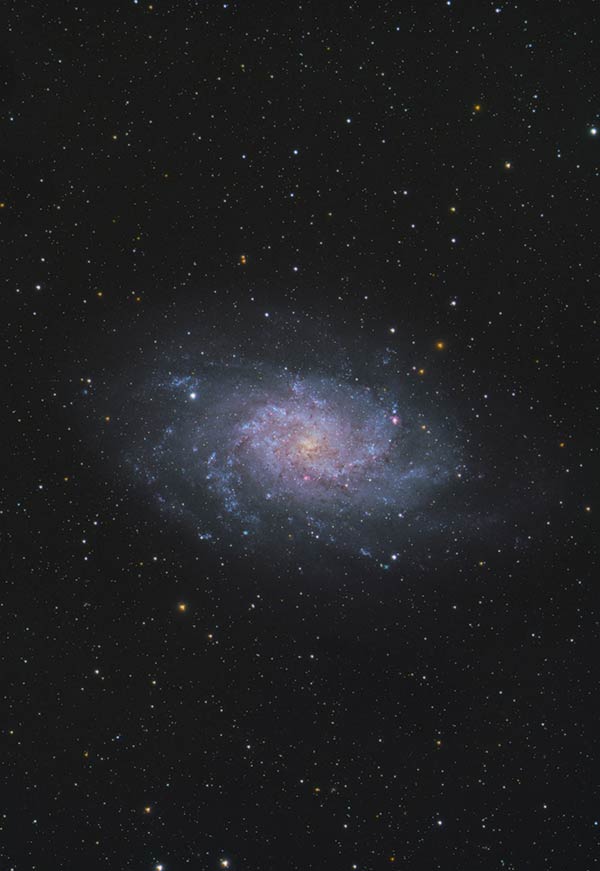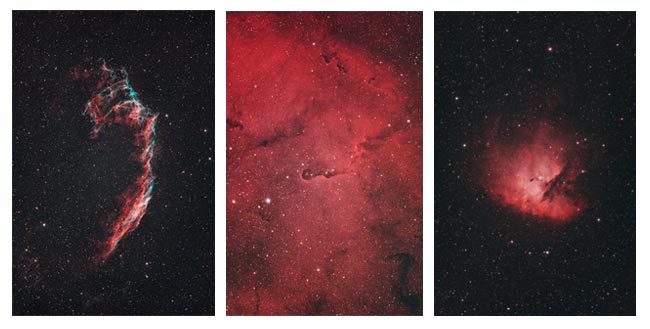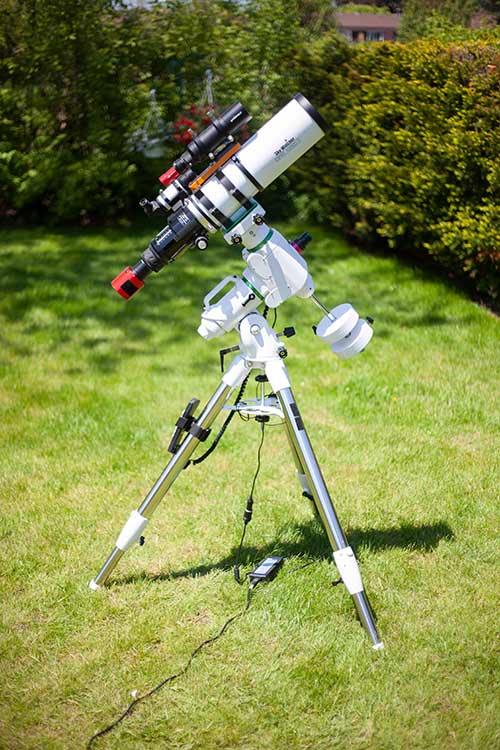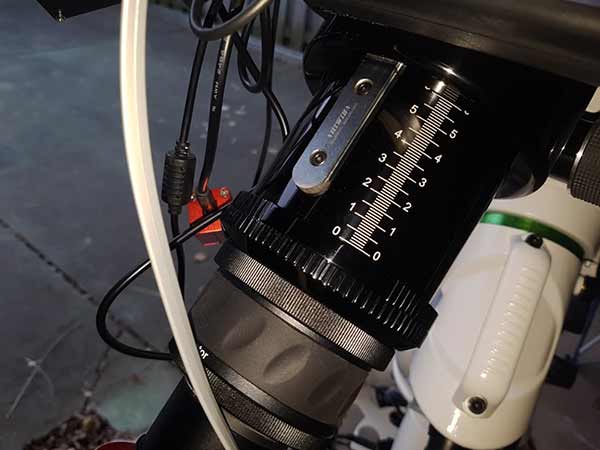Sky-Watcher Esprit 100 Review
The Sky-Watcher Esprit 100 is an apochromatic refractor telescope designed for wide-field astrophotography. The Esprit 100 is a triplet refracting telescope, meaning it uses 3 lenses to produce images with excellent color correction.
Being a huge fan of wide-field APOs myself, I had a feeling that the Esprit 100 ED would help me produce the type of images I strive for. Its compact size, precision focuser, and included accessories make this an attractive choice for amateur astrophotographers looking to capture wide, deep-sky images.
This telescope is included on my list of best telescopes for astrophotography, along with sample images taken through each one. If you in the market for a premium, wide-field refractor telescope, it is hard to beat the Sky-Watcher Esprit 100 ED APO.
From the moment I fastened the lime green mounting plate to its base, the Sky-Watcher Esprit 100 APO has been an impressive optical instrument to experience. I’ve managed to capture some impressive images using this telescope, from the backyard and beyond.
In this review, I’ll tell you exactly what I like about the Esprit 100, and share some of my astrophotography results using it. This Sky-Watcher Esprit 100 ED was generously loaned to me directly from Sky-Watcher USA for review. As with all of the items I review for astrophotography, I was not paid to endorse this telescope.
Sky-Watcher Esprit 100 Review
With a focal length of 550mm and F-Ratio of F/5.5, this compact triplet can produce dramatic astrophotography images of the type of deep-sky objects I go after. This includes large nebulae like the Eastern Veil Nebula in Cygnus pictured below.
If you’re a fan of large nebulae targets like the Lagoon Nebula, Eagle Nebula, and the Rosette Nebula, the native magnification of the Esprit 100 is a perfect fit. Large galaxies such as the Andromeda Galaxy or Triangulum Galaxy are also possible using the right camera.
The Eastern Veil Nebula captured using the Sky-Watcher Esprit 100 ED
Apochromatic refractors like the Esprit 100 are perfect for deep sky astrophotography enthusiasts, because of their versatility, compact size, and imaging performance. With the right camera, large targets such as the North America Nebula will fit within a single image frame.
Wide-field refractors are generally more “forgiving” than longer focal length telescopes. This makes them a great choice for beginners because they do not require the level of tracking accuracy and autoguiding performance a larger instrument does.
Make no mistake, this refractor is intended for deep-sky astrophotography, not planetary imaging or visual observations. The Sky-Watcher Esprit 100 package does include visual accessories like a diagonal and finderscope, but I am yet to look through the telescope with my eye. For me, it’s all about the pictures.
Large deep-sky objects like the Triangulum Galaxy are a perfect fit for the Esprit 100.
As you can see in the photo above, the Esprit 100 does a great job of capturing accurate star colors that are small and crisp. A one-shot-color camera like the ZWO ASI294MC Pro is a fantastic companion to this ‘scope.
Smaller targets such as several galaxies and the planets are better suited for a telescope with a longer focal length such as an SCT or Ritchey–Chrétien. If you want high magnification views of smaller galaxies and the planets, you’ll want a telescope with a focal length of 1000mm or more.
A Triplet APO for Astrophotography
The premium optical materials used in this telescope include an objective lens with FPL-53 glass. The field flatness and color correction of the Sky-Watcher Esprit 100 ED is noticeable, even in a single exposure. My jaw nearly hit the pavement when I saw that first unprocessed image on the Veil Nebula appear on the screen.
I have used many apochromatic refractors for astrophotography, and the quality of the stars produced by the Esprit 100 appear to be as good if not better than any other refractor I’ve used.
Images captured using the Sky-Watcher Esprit 100 ED APO
This “Super APO” refractor is a 100mm diameter telescope constructed with air-spaced ED APO triplet optics. The three-element objective lens design uses high-end BK-7 and FPL-53 glass which results in astrophotography images that are free of false color.
The optical tube is roughly 15 pounds, very stocky and solid despite its compact size. It’s lightweight enough to use with entry-level equatorial telescope mounts such as the Orion Sirus EQ-G or Celestron AVX (I’ve mounted the Sky-Watcher Esprit 100 to the EQ6-R Pro).
The length of the optical tube assembly is just under 25 inches with the dew shield fully retracted. Here is a look at the Esprit 100 with a number of imaging accessories attached in my backyard.
My astrophotography setup including the Sky-Watcher Esprit 100 refractor.
I’ve mounted a 60mm StarField guide scope for autoguiding. To do this, I fastened a 200mm dovetail plate to the top of the tube rings that came with the Esprit.
This allowed me to better balance my imaging configuration and left a spot for the Sky-Watcher 9 x 50 Finderscope in its native mounting bracket. Having both a finderscope and guide scope mounted to the Esprit means that I can easily run a 3-star alignment routine without swapping out the guide camera for an eyepiece.
The Sky-Watcher Esprit 100 currently tracks the movement of the night sky on a “matching” Sky-Watcher EQ6-R Pro mount. This is an attractive mount/telescope combination for deep sky astrophotographers, although the EQ-6 R can handle much larger optical tubes such as the Esprit 150.
Features and Accessories
The package I received from Sky-Watcher had everything needed to start imaging. This included an impressive number of accessories from a 9 x 50 erect-image finderscope to a padded aluminum case. You can watch my unboxing video of this telescope below:
I’ve also run this camera and telescope configuration using the ZWO ASIair wifi device. The Esprit 100 has a nice flat surface on top of the focuser drawtube to mount accessories like an onboard mini-computer or Pegasus Astro Pocket Power Box.
The Sky-Watcher Esprit 100 ED package includes a dedicated field flattener, 2″ dielectric diagonal, 9 x 50 finderscope, Canon camera adapter, tube rings, mounting plate, and an aluminum carry case.
The dew shield on the Esprit is very long (7″) which is great for blocking stray light and protecting the objective from condensation. It’s also retractable, which can save a lot of space when storing the telescope or traveling with it.
The internal knife-edge baffles are designed to improve contrast and avoid stray light from entering the optical system. I believe all of the APO refractors I have ever used offer this feature, and the Esprit 100 is no different.
Esprit 100 ED Specifications:
- Optical Design: Apochromatic Refractor
- Glass Type: FPL-53
- Diameter: 100mm
- Focal Length: 550mm
- F/Ratio: f/5.5
- Finder Scope: 8×50 right-angle erect finder
- Focuser Diameter: 3″ Linear Power Focuser
- Diagonal: 2″ 90 deg. Dielectric Diagonal with 1.25″ adapter
- Tube Weight: 6.3 kg
The pixel size (4.63) of my ZWO ASI294MC Pro camera is a great fit for the Sky-Watcher Esprit 100 ED. Ideally, your image scale will fall in the range of 1.0 – 2.0 to be well sampled. The math for this equation is below:
pixel size (4.63) / focal length (550) x 206 = 1.73
For an easy-to-understand description of the importance of not under or over-sampling your image, watch this video from Chuck Ayoub.
A Flat Full-Frame Field
The included thread-on field corrector (flattener) ensures that images captured using my full-frame DSLR camera have sharp stars to the edges of the frame.
I appreciate it when brands offer a package that includes the recommended field flattener as a package. This is one aspect of your imaging train you want to get right. The correct spacing between your camera sensor and this flattener has been discussed in detail in the Cloudy Nights forum.
The 40mm imaging circle of the Sky-Watcher Esprit 100 ED was designed with full-frame DSLR imagers in mind, as the package I received even included a Canon EOS M48 adapter ring.
The camera I have used most with the Esprit 100, however, is the ZWO ASI294MC Pro. A cooled one-shot-color CMOS dedicated astronomy camera. I have found the image scale of this camera to be a perfect fit for the Sky-Watcher Esprit 100 ED.
For reference, have a look at the native field of view using this camera and telescope combo on the Cave Nebula:
The Cave Nebula in Cepheus. ZWO ASI294MC Pro and Esprit 100.
The imaging performance of the Sky-Watcher Esprit 100 ED is evident in this photo. This image was shot from Bortle Class 6 skies in the city, using a one-shot-color camera and narrowband filters.
Capturing detailed portraits of nebulae like this from my light-polluted backyard is truly a remarkable feat and one that can be replicated using similar equipment.
2.7″ Linear Power Focuser
The robust Helinear track focuser on the Esprit 100 holds its position firmly in the imaging train. A great example of this is being able to retain perfect focus after a rather jostling meridian flip. I use a Bahtinov mask to re-check the focus again after this routine, but the Esprit 100 has always kept the focuser in its precise position.
The focuser includes a secondary linear rail, which adds to its rigidity. It includes micro-focusing abilities, which can be very handy when shooting with strong narrowband filters as there is no image shift to worry about.
The smooth and reliable focuser on the Sky-Watcher Esprit 100 ED is one of my favorite features of the telescope overall. I think you’ll find a similar response from fellow owners of this Esprit and the larger models.
Example Astrophotos
Since receiving the telescope in August, I have tested the Esprit 100 on a number of deep-sky objects. The F-Ratio of this APO (F/5.5) makes a 4-minute exposure the sweet spot for my astronomy camera when shooting with narrowband filters.
Using a Gain setting of 120 (Unity Gain) on the AS294MC Pro has resulted in images with an attractive histogram when in use on the Esprit 100. Image sharpness and contrast are this telescope’s specialty, a trait I experienced firsthand from the backyard.
Using a duo-narrowband filter, I was able to collect some much-need H II details on the Crescent Nebula using the Esprit 100. As you can see, even medium-sized nebulae like NGC 6888 are a great fit for this focal length, because you can get really creative with the framing and add surrounding nebulae.
The Crescent Nebula in Cygnus. Dual Bandpass filter and OSC Camera.
The image of the Elephant’s Trunk Nebula below is a great example of the wide field of view the Esprit 100 provides. IC 1396 is a massive target, that can be tough to capture in a single image.
With the 550mm focal length of the Esprit 100, a large portion of this nebula fits into the image frame using a 10MP 4/3″ camera sensor. A full-frame 35mm image sensor would capture even more of this interesting area.
The Elephant’s Trunk Nebula in Cepheus.
Final Thoughts
I’ve tested the Sky-Watcher Esprit 100 ED in terms of astrophotography performance with both a full-frame DSLR camera (Canon EOS 5D Mark II) and a cooled CMOS camera (ZWO ASI294MC Pro). Some of the best astrophotography images I’ve ever taken were captured using this telescope.
I am certain that users will find the visual performance of this refractor to be more than satisfactory, but this review focuses on the deep-sky astrophotography capabilities of the Esprit.
If your interests lie in deep-sky imaging, particularly in wide-field targets such as emission nebulae and large galaxies like Andromeda, I think you will be more than satisfied with the Sky-Watcher Esprit 100.
The premium optics used in this telescope prove their value by consistently producing incredibly sharp, high-contrast images. Whether you’re looking to connect a full-frame DSLR or a cooled dedicated astronomy camera to the Esprit 100, I think you’ll be truly amazed at what’s possible with this compact APO.
The convenience, portability, and premium features such as the 3″ focuser result in an enjoyable user experience that’s tough to match in this category.
The Sky-Watcher Esprit 100 mm ED APO is Available at Agena Astro.











